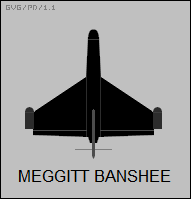Meggitt Banshee
The Meggitt BTT-3 Banshee, formerly the Target Technology Banshee, is a British target drone developed in the 1980s for air defence systems training.
| Meggitt BTT-3 Banshee | |
|---|---|
 | |
| A team of Royal Brunei Armed Forces military and civilian contractors prepare "Banshee" unmanned drones for launch from the U.S. Navy's dock landing ship USS Fort McHenry (LSD 43). | |
| Role | Target Drone |
| National origin | United Kingdom |
| Manufacturer | Meggitt Defence Systems |
| First flight | 1983 |
| Introduction | 1984 |
| Status | In service |
| Primary user | British Army |
| Number built | Over 7000 [1] |
| Developed into | SAGEM Crecerelle |
Design and development
The Banshee was developed by Target Technology Ltd..[2] The company had been specialising in lightweight engines for drones and had developed its own design in 1983 [3]
The Banshee is a built mostly out of composite material (Kevlar and glass-reinforced plastic) with a tailless delta wing planform. The first models used a 26 hp 342 cc Normalair-Garrett two-cylinder two-stroke driving a pusher propeller. Performance was 35-185 kt with an endurance from 1–3 hours. Flight control is by two elevons. 185kt. Later models used Norton P73 rotary engines[4][5]
The Banshee is designed to float for overwater operations recovery. Installable options include, radar enhancement devices, flare or chaff dispenser, and target sleeves. It can simulate a sea-skimming missile or serve as a reconnaissance UAV with a camera.
Operational history
Banshee entered service with the British Army in the mid-1980s as an aerial target for the Short Blowpipe and Javelin shoulder-launched missiles.[6]
The Banshee has been deployed in over 40 Countries.[7] It has been tested against Blowpipe, Chaparral, Crotale, Javelin, Phalanx, Rapier, Sea Sparrow Akash SAM and Barak 8 SAM systems.[8]
Operators
Variants
- Banshee 300 - Sea skimmer (1988)
- Banshee 400 - Reconnaissance (2001)
- Jet Banshee - faster drone
On Display
- Serial 1364 - Science Museum, London[9]
- Serial 3088 - City of Norwich Aviation Museum[10]
Specifications Meggitt BTT-3 Banshee

Data from Meggitt
General characteristics
- Crew: None
- Length: 2.84 m (9 ft 4 in)
- Wingspan: 2.49 m (8 ft 2 in)
- Height: 0.86 m (2 ft 10 in)
- Empty weight: 39 kg (85 lb)
- Gross weight: 73 kg (160 lb)
- Powerplant: 1 × Norton P73 Wankel rotary engine, 28 kW (38 hp)
Performance
- Maximum speed: 200 km/h (120 mph, 110 kn)
- Endurance: 1 hour 15 minutes
- Service ceiling: 7,000 m (23,000 ft)
References
- "Banshee". Archived from the original on 8 July 2011. Retrieved 7 January 2011.
- "Target Drones". Retrieved 7 January 2011.
- New UK target RPV in pdfarchive at flightglobal.com
- http://www.flightglobal.com/pdfarchive/view/1988/1988%20-%201940.html
- UK funding for rotary engine in pdfarchive at flightglobal.com
- http://www.flightglobal.com/pdfarchive/view/1986/1986%20-%201877.html
- "Banshee". Archived from the original on 14 July 2011. Retrieved 7 January 2011.
- "Meggitt BTT-3 Banshee". Retrieved 7 January 2011.
- Ellis, Ken (2016). Wrecks & Relics (25th ed.). Crecy. p. 162. ISBN 978 191080 9037.
- "CNAM - Banshee 300, 3088". www.cnam.org.uk. Retrieved 4 June 2017.